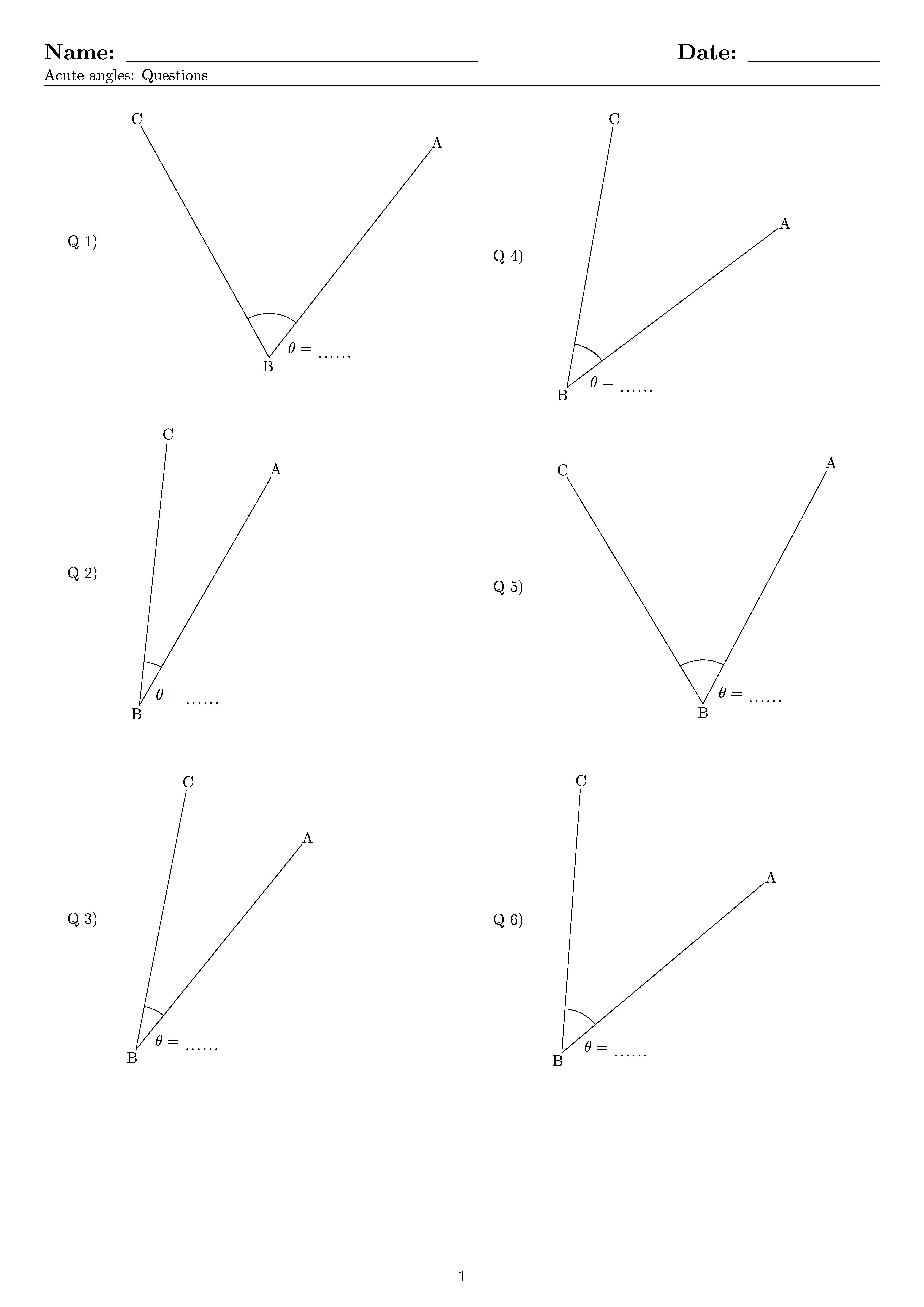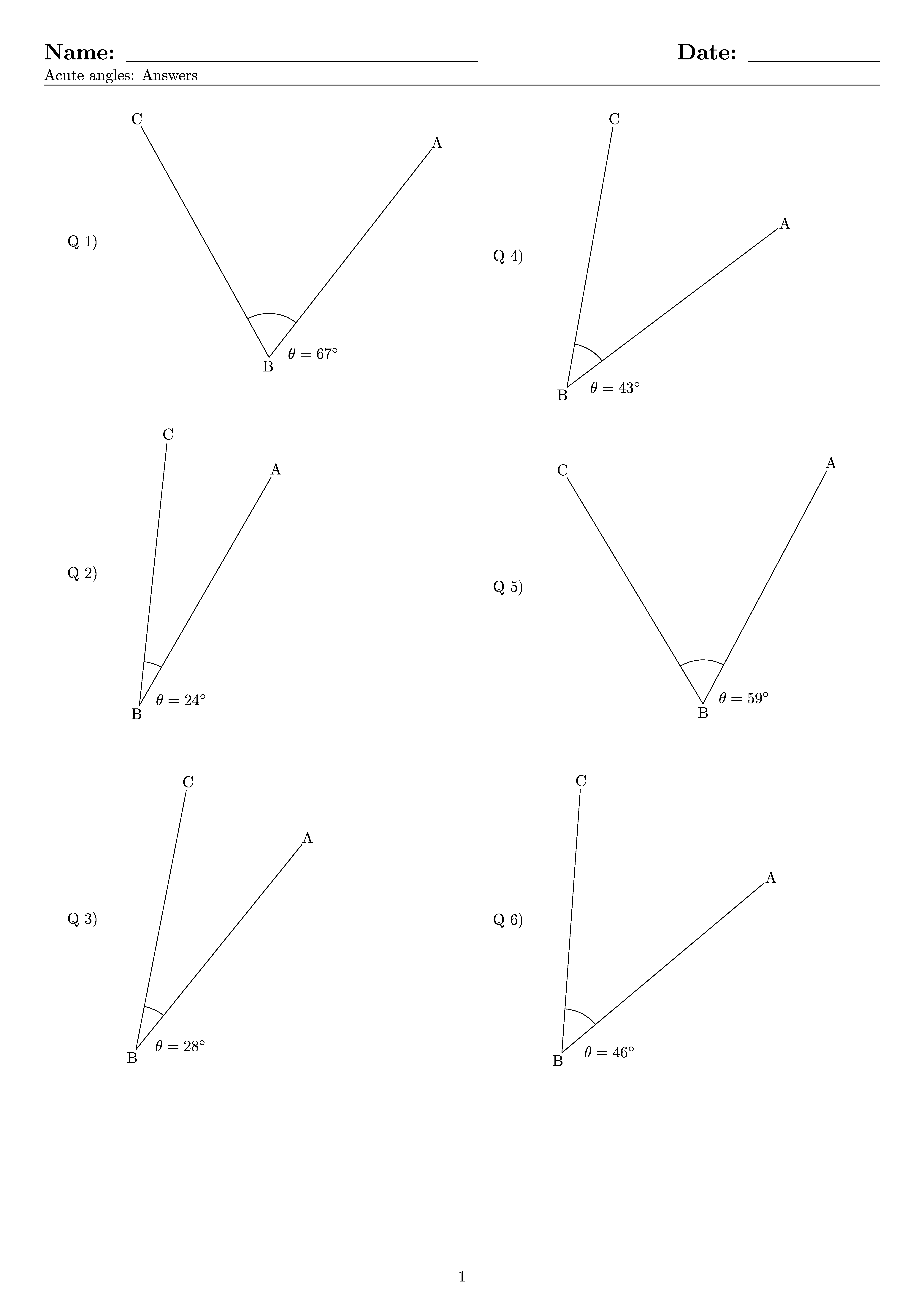1. Measuring angles
Diagrams of acute, obtuse and reflex angles are below.
These are LaTeX generated only with the answer sheet first followed by the question sheet in the pdfs.
1.1. Question page
A sample question page file is shown below.

1.2. Answer page
A sample answer page file is shown below.

1.3. Tex and pdf files
A 2 page worksheet for obtuse angles:
A 2 page worksheet for reflex angles:
1.4. Acute angles
The .tex file to regenerate random acute angles is shown below.
\documentclass{article}
\usepackage{tikz}
\usepackage{multicol}
\usepackage{fancyhdr}
% Underlining package
\usepackage{ulem}
\usepackage[a4paper, portrait, margin=1cm]{geometry}
\def \HeadingAnswers {\section*{\Large Name: \underline{\hspace{8cm}} \hfill Date: \underline{\hspace{3cm}}} \vspace{-3mm}
{Acute angles: Answers} \vspace{1pt}\hrule}
\def \HeadingQuestions {\section*{\Large Name: \underline{\hspace{8cm}} \hfill Date: \underline{\hspace{3cm}}} \vspace{-3mm}
{Acute angles: Questions} \vspace{1pt}\hrule}
% raise footer with page number; no header
\fancypagestyle{myfancypagestyle}{
\fancyhf{}% clear all header and footer fields
\renewcommand{\headrulewidth}{0pt} % no rule under header
\fancyfoot[C] {\thepage} \setlength{\footskip}{12pt} % raise page number 6pt
}
\pagestyle{myfancypagestyle} % apply myfancypagestyle
\pgfmathsetmacro{\arm}{6}
\pgfmathsetmacro{\minAngle}{20}
\pgfmathsetmacro{\maxAngle}{85}
\pgfmathsetmacro{\minAngleAB}{0}
\pgfmathsetmacro{\maxAngleAB}{85}
% \pgfmathsetmacro{\coldiag}{3}
\pgfmathsetmacro{\maxdiag}{12}
\begin{document}
\HeadingAnswers
\vspace{1mm}
\begin{multicols}{2}
\def\AngleList{}
\def\AngleABList{}
\foreach \x in {1,...,\maxdiag} {
\pgfmathsetmacro{\Angle}{random(\minAngle,\maxAngle)}
\pgfmathsetmacro{\AngleAB}{random(\minAngleAB,\maxAngleAB)}
% the first item in the array is blank, then items 1 to 10 are stored
\xdef\AngleList{\AngleList,\Angle}
\xdef\AngleABList{\AngleABList,\AngleAB}
\pgfmathsetmacro{\xA}{\arm *cos(\AngleAB)}
\pgfmathsetmacro{\yA}{\arm *sin(\AngleAB)}
\pgfmathsetmacro{\xC}{\arm *cos(\Angle + \AngleAB)}
\pgfmathsetmacro{\yC}{\arm *sin(\Angle + \AngleAB)}
\pgfmathsetmacro{\ABClabelX}{0.5*cos(\AngleAB)}
\pgfmathsetmacro{\ABClabelY}{0.5*sin(\AngleAB) - 0.3}
\pgfmathsetmacro{\xarcAB}{1*cos(\AngleAB)}
\pgfmathsetmacro{\yarcAB}{1*sin(\AngleAB)}
\pgfmathsetmacro{\AlabelX}{\xA + 0.2*cos(\AngleAB)}
\pgfmathsetmacro{\AlabelY}{\yA + 0.2*sin(\AngleAB)}
\pgfmathsetmacro{\ClabelX}{\xC + 0.2*cos(\Angle + \AngleAB)}
\pgfmathsetmacro{\ClabelY}{\yC + 0.2*sin(\Angle + \AngleAB)}
\pgfmathsetmacro{\BlabelX}{-0.2*cos(\Angle/2 + \AngleAB)}
\pgfmathsetmacro{\BlabelY}{-0.2*sin(\Angle/2 + \AngleAB)}
\begin{minipage}[t]{0.1\linewidth}
Q \x)
\end{minipage}
\hspace{0.1cm}
\begin{minipage}[]{0.8\linewidth}
\begin{tikzpicture}
\coordinate (A) at (0,0);
\coordinate (B) at (\xA,\yA);
\coordinate (C) at (\xC,\yC);
\draw (A) -- (B) -- cycle;
\draw (A) -- (C) -- cycle;
\draw[-] (\xarcAB,\yarcAB) arc [start angle=\AngleAB, end angle=\Angle + \AngleAB, radius=1cm];
\node[right] at (\ABClabelX,\ABClabelY) {\raggedright $\theta = \Angle^\circ$};
\node[] at (\BlabelX,\BlabelY) {B};
\node[] at (\AlabelX,\AlabelY) {A};
\node[] at (\ClabelX,\ClabelY) {C};
\end{tikzpicture}
\end{minipage}
\vspace{1cm}
% \ifnum\x=\coldiag
% \vfill\null
% \columnbreak
% \fi
}
\end{multicols}
\cleardoublepage
\setcounter{page}{1}
\newpage
\HeadingQuestions
\vspace{1mm}
\begin{multicols}{2}
% Iterate over the values in the angleList array
\foreach \x in {1,...,\maxdiag} {
\pgfmathsetmacro{\Angle}{{\AngleList}[\x]}
\pgfmathsetmacro{\AngleAB}{{\AngleABList}[\x]}
\pgfmathsetmacro{\xA}{\arm *cos(\AngleAB)}
\pgfmathsetmacro{\yA}{\arm *sin(\AngleAB)}
\pgfmathsetmacro{\xC}{\arm *cos(\Angle + \AngleAB)}
\pgfmathsetmacro{\yC}{\arm *sin(\Angle + \AngleAB)}
\pgfmathsetmacro{\ABClabelX}{0.5*cos(\AngleAB)}
\pgfmathsetmacro{\ABClabelY}{0.5*sin(\AngleAB) - 0.3}
\pgfmathsetmacro{\xarcAB}{1*cos(\AngleAB)}
\pgfmathsetmacro{\yarcAB}{1*sin(\AngleAB)}
\pgfmathsetmacro{\AlabelX}{\xA + 0.2*cos(\AngleAB)}
\pgfmathsetmacro{\AlabelY}{\yA + 0.2*sin(\AngleAB)}
\pgfmathsetmacro{\ClabelX}{\xC + 0.2*cos(\Angle + \AngleAB)}
\pgfmathsetmacro{\ClabelY}{\yC + 0.2*sin(\Angle + \AngleAB)}
\pgfmathsetmacro{\BlabelX}{-0.2*cos(\Angle/2 + \AngleAB)}
\pgfmathsetmacro{\BlabelY}{-0.2*sin(\Angle/2 + \AngleAB)}
\begin{minipage}[t]{0.1\linewidth}
Q \x)
\end{minipage}
\hspace{0.1cm}
\begin{minipage}[]{0.8\linewidth}
\begin{tikzpicture}
\coordinate (A) at (0,0);
\coordinate (B) at (\xA,\yA);
\coordinate (C) at (\xC,\yC);
\draw (A) -- (B) -- cycle;
\draw (A) -- (C) -- cycle;
\draw[-] (\xarcAB,\yarcAB) arc [start angle=\AngleAB, end angle=\Angle + \AngleAB, radius=1cm];
\node[right] at (\ABClabelX,\ABClabelY) {\raggedright $\theta = \dotuline{~~~~~~~}$};
\node[] at (\BlabelX,\BlabelY) {B};
\node[] at (\AlabelX,\AlabelY) {A};
\node[] at (\ClabelX,\ClabelY) {C};
\end{tikzpicture}
\end{minipage}
\vspace{1cm}
% \ifnum\x=\coldiag
% \vfill\null
% \columnbreak
% \fi
}
\end{multicols}
\end{document}
1.5. Obtuse angles
The .tex file to regenerate random obtuse angles is shown below.
\documentclass{article}
\usepackage{tikz}
\usepackage{multicol}
\usepackage{fancyhdr}
% Underlining package
\usepackage{ulem}
\usepackage[a4paper, portrait, margin=1cm]{geometry}
\def \HeadingAnswers {\section*{\Large Name: \underline{\hspace{8cm}} \hfill Date: \underline{\hspace{3cm}}} \vspace{-3mm}
{Obtuse angles: Answers} \vspace{1pt}\hrule}
\def \HeadingQuestions {\section*{\Large Name: \underline{\hspace{8cm}} \hfill Date: \underline{\hspace{3cm}}} \vspace{-3mm}
{Obtuse angles: Questions} \vspace{1pt}\hrule}
% raise footer with page number; no header
\fancypagestyle{myfancypagestyle}{
\fancyhf{}% clear all header and footer fields
\renewcommand{\headrulewidth}{0pt} % no rule under header
\fancyfoot[C] {\thepage} \setlength{\footskip}{12pt} % raise page number 6pt
}
\pagestyle{myfancypagestyle} % apply myfancypagestyle
\pgfmathsetmacro{\arm}{6}
\pgfmathsetmacro{\minAngle}{95}
\pgfmathsetmacro{\maxAngle}{180}
\pgfmathsetmacro{\minAngleAB}{0}
\pgfmathsetmacro{\maxAngleAB}{30}
\pgfmathsetmacro{\maxdiag}{8}
\begin{document}
\HeadingAnswers
\vspace{1mm}
\def\AngleList{}
\def\AngleABList{}
\foreach \x in {1,...,\maxdiag} {
\pgfmathsetmacro{\Angle}{random(\minAngle,\maxAngle)}
\pgfmathsetmacro{\AngleAB}{random(\minAngleAB,\maxAngleAB)}
% the first item in the array is blank, then items 1 to 10 are stored
\xdef\AngleList{\AngleList,\Angle}
\xdef\AngleABList{\AngleABList,\AngleAB}
\pgfmathsetmacro{\xB}{\arm *cos(\AngleAB)}
\pgfmathsetmacro{\yB}{\arm *sin(\AngleAB)}
\pgfmathsetmacro{\xC}{\arm *cos(\Angle + \AngleAB)}
\pgfmathsetmacro{\yC}{\arm *sin(\Angle + \AngleAB)}
\pgfmathsetmacro{\BAClabelX}{0.5*cos(\AngleAB)}
\pgfmathsetmacro{\BAClabelY}{0.5*sin(\AngleAB) - 0.3}
\pgfmathsetmacro{\xarcB}{1*cos(\AngleAB)}
\pgfmathsetmacro{\yarcB}{1*sin(\AngleAB)}
\pgfmathsetmacro{\BlabelX}{\xB + 0.2*cos(\AngleAB)}
\pgfmathsetmacro{\BlabelY}{\yB + 0.2*sin(\AngleAB)}
\pgfmathsetmacro{\ClabelX}{\xC + 0.2*cos(\Angle + \AngleAB)}
\pgfmathsetmacro{\ClabelY}{\yC + 0.2*sin(\Angle + \AngleAB)}
\pgfmathsetmacro{\AlabelX}{-0.2*cos(\Angle/2 + \AngleAB)}
\pgfmathsetmacro{\AlabelY}{-0.2*sin(\Angle/2 + \AngleAB)}
\begin{minipage}[t]{0.1\linewidth}
Q \x)
\end{minipage}
\hspace{0.2cm}
\begin{minipage}[]{0.8\linewidth}
\begin{tikzpicture}
\coordinate (A) at (0,0);
\coordinate (B) at (\xB,\yB);
\coordinate (C) at (\xC,\yC);
\draw (A) -- (B) -- cycle;
\draw (A) -- (C) -- cycle;
\draw[-] (\xarcB,\yarcB) arc [start angle=\AngleAB, end angle=\Angle + \AngleAB, radius=1cm];
\node[right] at (\BAClabelX,\BAClabelY) {\raggedright $\theta = \Angle^\circ$};
\node[] at (\AlabelX,\AlabelY) {A};
\node[] at (\BlabelX,\BlabelY) {B};
\node[] at (\ClabelX,\ClabelY) {C};
\end{tikzpicture}
\end{minipage}
\vspace{1cm}
}
\cleardoublepage
\setcounter{page}{1}
\newpage
\HeadingQuestions
\vspace{1mm}
% Iterate over the values in the angleList array
\foreach \x in {1,...,\maxdiag} {
\pgfmathsetmacro{\Angle}{{\AngleList}[\x]}
\pgfmathsetmacro{\AngleAB}{{\AngleABList}[\x]}
\pgfmathsetmacro{\xB}{\arm *cos(\AngleAB)}
\pgfmathsetmacro{\yB}{\arm *sin(\AngleAB)}
\pgfmathsetmacro{\xC}{\arm *cos(\Angle + \AngleAB)}
\pgfmathsetmacro{\yC}{\arm *sin(\Angle + \AngleAB)}
\pgfmathsetmacro{\BAClabelX}{0.5*cos(\AngleAB)}
\pgfmathsetmacro{\BAClabelY}{0.5*sin(\AngleAB) - 0.3}
\pgfmathsetmacro{\xarcB}{1*cos(\AngleAB)}
\pgfmathsetmacro{\yarcB}{1*sin(\AngleAB)}
\pgfmathsetmacro{\BlabelX}{\xB + 0.2*cos(\AngleAB)}
\pgfmathsetmacro{\BlabelY}{\yB + 0.2*sin(\AngleAB)}
\pgfmathsetmacro{\ClabelX}{\xC + 0.2*cos(\Angle + \AngleAB)}
\pgfmathsetmacro{\ClabelY}{\yC + 0.2*sin(\Angle + \AngleAB)}
\pgfmathsetmacro{\AlabelX}{-0.2*cos(\Angle/2 + \AngleAB)}
\pgfmathsetmacro{\AlabelY}{-0.2*sin(\Angle/2 + \AngleAB)}
\begin{minipage}[t]{0.1\linewidth}
Q \x)
\end{minipage}
\hspace{0.2cm}
\begin{minipage}[]{0.8\linewidth}
\begin{tikzpicture}
\coordinate (A) at (0,0);
\coordinate (B) at (\xB,\yB);
\coordinate (C) at (\xC,\yC);
\draw (A) -- (B) -- cycle;
\draw (A) -- (C) -- cycle;
\draw[-] (\xarcB,\yarcB) arc [start angle=\AngleAB, end angle=\Angle + \AngleAB, radius=1cm];
\node[right] at (\BAClabelX,\BAClabelY) {\raggedright $\theta = \dotuline{~~~~~~~}$};
\node[] at (\AlabelX,\AlabelY) {A};
\node[] at (\BlabelX,\BlabelY) {B};
\node[] at (\ClabelX,\ClabelY) {C};
\end{tikzpicture}
\end{minipage}
\vspace{1cm}
}
\end{document}
1.6. Reflex angles
The .tex file to regenerate random reflex angles is shown below.
\documentclass{article}
\usepackage{tikz}
\usepackage{multicol}
\usepackage{fancyhdr}
% Underlining package
\usepackage{ulem}
\usepackage[a4paper, portrait, margin=1cm]{geometry}
\def \HeadingAnswers {\section*{\Large Name: \underline{\hspace{8cm}} \hfill Date: \underline{\hspace{3cm}}} \vspace{-3mm}
{Reflex angles: Answers} \vspace{1pt}\hrule}
\def \HeadingQuestions {\section*{\Large Name: \underline{\hspace{8cm}} \hfill Date: \underline{\hspace{3cm}}} \vspace{-3mm}
{Reflex angles: Questions} \vspace{1pt}\hrule}
% raise footer with page number; no header
\fancypagestyle{myfancypagestyle}{
\fancyhf{}% clear all header and footer fields
\renewcommand{\headrulewidth}{0pt} % no rule under header
\fancyfoot[C] {\thepage} \setlength{\footskip}{12pt} % raise page number 6pt
}
\pagestyle{myfancypagestyle} % apply myfancypagestyle
\pgfmathsetmacro{\arm}{6}
\pgfmathsetmacro{\minAngle}{270}
\pgfmathsetmacro{\maxAngle}{350}
\pgfmathsetmacro{\minAngleAB}{0}
\pgfmathsetmacro{\maxAngleAB}{180}
\pgfmathsetmacro{\maxdiag}{6}
\begin{document}
\HeadingAnswers
\vspace{1mm}
\def\AngleList{}
\def\AngleABList{}
\foreach \x in {1,...,\maxdiag} {
\pgfmathsetmacro{\Angle}{random(\minAngle,\maxAngle)}
\pgfmathsetmacro{\AngleAB}{random(\minAngleAB,\maxAngleAB)}
% the first item in the array is blank, then items 1 to 10 are stored
\xdef\AngleList{\AngleList,\Angle}
\xdef\AngleABList{\AngleABList,\AngleAB}
\pgfmathsetmacro{\xB}{\arm *cos(\AngleAB)}
\pgfmathsetmacro{\yB}{\arm *sin(\AngleAB)}
\pgfmathsetmacro{\xC}{\arm *cos(\Angle + \AngleAB)}
\pgfmathsetmacro{\yC}{\arm *sin(\Angle + \AngleAB)}
\pgfmathsetmacro{\BAClabelX}{-.5*cos(\AngleAB)-3}
\pgfmathsetmacro{\BAClabelY}{-.5*sin(\AngleAB)-0.1}
\pgfmathsetmacro{\xarcB}{1*cos(\AngleAB)}
\pgfmathsetmacro{\yarcB}{1*sin(\AngleAB)}
\pgfmathsetmacro{\BlabelX}{\xB + 0.2*cos(\AngleAB)}
\pgfmathsetmacro{\BlabelY}{\yB + 0.2*sin(\AngleAB)}
\pgfmathsetmacro{\ClabelX}{\xC + 0.2*cos(\Angle + \AngleAB)}
\pgfmathsetmacro{\ClabelY}{\yC + 0.2*sin(\Angle + \AngleAB)}
\pgfmathsetmacro{\AlabelX}{0.2*cos(\Angle/2 + \AngleAB)}
\pgfmathsetmacro{\AlabelY}{0.2*sin(\Angle/2 + \AngleAB)}
\begin{minipage}[t]{0.1\linewidth}
Q \x)
\end{minipage}
\hspace{0.2cm}
\begin{minipage}[]{0.8\linewidth}
\begin{tikzpicture}
\coordinate (A) at (0,0);
\coordinate (B) at (\xB,\yB);
\coordinate (C) at (\xC,\yC);
\draw (A) -- (B) -- cycle;
\draw (A) -- (C) -- cycle;
\draw[-] (\xarcB,\yarcB) arc [start angle=\AngleAB, end angle=\Angle + \AngleAB, radius=1cm];
\node[right] at (\BAClabelX,\BAClabelY) {\raggedright $\theta = \Angle^\circ$};
\node[] at (\AlabelX,\AlabelY) {A};
\node[] at (\BlabelX,\BlabelY) {B};
\node[] at (\ClabelX,\ClabelY) {C};
\end{tikzpicture}
\end{minipage}
\vspace{1cm}
}
\cleardoublepage
\setcounter{page}{1}
\newpage
\HeadingQuestions
\vspace{1mm}
% Iterate over the values in the angleList array
\foreach \x in {1,...,\maxdiag} {
\pgfmathsetmacro{\Angle}{{\AngleList}[\x]}
\pgfmathsetmacro{\AngleAB}{{\AngleABList}[\x]}
\pgfmathsetmacro{\xB}{\arm *cos(\AngleAB)}
\pgfmathsetmacro{\yB}{\arm *sin(\AngleAB)}
\pgfmathsetmacro{\xC}{\arm *cos(\Angle + \AngleAB)}
\pgfmathsetmacro{\yC}{\arm *sin(\Angle + \AngleAB)}
\pgfmathsetmacro{\BAClabelX}{-.5*cos(\AngleAB)-3}
\pgfmathsetmacro{\BAClabelY}{-.5*sin(\AngleAB)-0.1}
\pgfmathsetmacro{\xarcB}{1*cos(\AngleAB)}
\pgfmathsetmacro{\yarcB}{1*sin(\AngleAB)}
\pgfmathsetmacro{\BlabelX}{\xB + 0.2*cos(\AngleAB)}
\pgfmathsetmacro{\BlabelY}{\yB + 0.2*sin(\AngleAB)}
\pgfmathsetmacro{\ClabelX}{\xC + 0.2*cos(\Angle + \AngleAB)}
\pgfmathsetmacro{\ClabelY}{\yC + 0.2*sin(\Angle + \AngleAB)}
\pgfmathsetmacro{\AlabelX}{0.2*cos(\Angle/2 + \AngleAB)}
\pgfmathsetmacro{\AlabelY}{0.2*sin(\Angle/2 + \AngleAB)}
\begin{minipage}[t]{0.1\linewidth}
Q \x)
\end{minipage}
\hspace{0.2cm}
\begin{minipage}[]{0.8\linewidth}
\begin{tikzpicture}
\coordinate (A) at (0,0);
\coordinate (B) at (\xB,\yB);
\coordinate (C) at (\xC,\yC);
\draw (A) -- (B) -- cycle;
\draw (A) -- (C) -- cycle;
\draw[-] (\xarcB,\yarcB) arc [start angle=\AngleAB, end angle=\Angle + \AngleAB, radius=1cm];
\node[right] at (\BAClabelX,\BAClabelY) {\raggedright $\theta = \dotuline{~~~~~~~}$};
\node[] at (\AlabelX,\AlabelY) {A};
\node[] at (\BlabelX,\BlabelY) {B};
\node[] at (\ClabelX,\ClabelY) {C};
\end{tikzpicture}
\end{minipage}
\vspace{1cm}
}
\end{document}